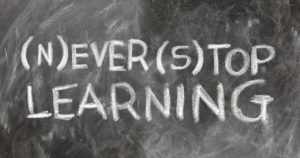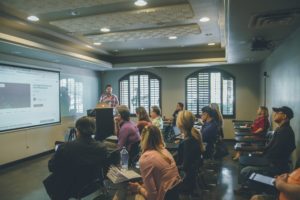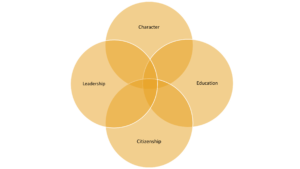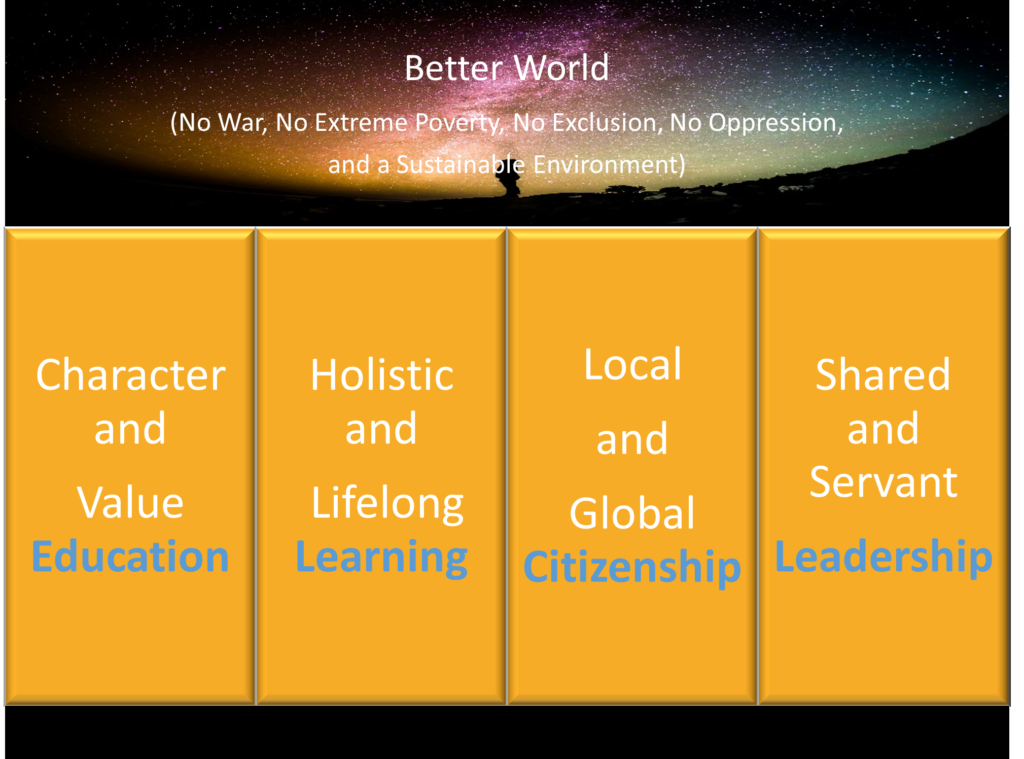Starting with the shared purpose of creating a Better World; one without war, poverty, oppression, exclusion, and with a sustainable planet, we need
- Good People developed through Character and Values Based Education.
- An Education of the whole person to unlock the full potential of each human being, and this must be a continual lifelong process.
- Development of an understanding of citizenship, local and global, and the shared nature of our purpose to create a better world for all.
- Finally, with shared purpose comes shared responsibility, and thus the need for each of us to serve and share in leadership toward a better world.
Introduction of the 4 Pillars for a Better World
- Character and Values Education
- Holistic and Lifelong Learning
- Global and Local Citizenship
- Shared and Servant Leadership
Pillar 1: Character Education
“Intelligence plus character – that is the goal of true education.” Martin Luther King
The complex nature of the problems we are trying to solve, will require, first and foremost, intelligent people knowledgeable in multiple areas. The planet is struggling in so many ways that it will take brilliant people at all levels to unwrap, research and devise solutions, and brilliance as any educator knows can come from anywhere and anyone. It just needs to be cultivated, unlocked, and allowed.
In terms of knowledge, there is a tremendous amount of good education occurring in the world. When I entered the field of education, I was immediately exposed to schools on a global basis such and interacted with educators globally. What I found to be most encouraging, and very consistent, was the passion and dedication of teachers in classrooms around the world. If you ever want to believe in the potential of young people, talk to an educator.
It is beyond the academics, however, where there is a greater need in creating a better world. While the problems are complex, each have a very human aspect to them, and the very existence of each shows a level of inhumanity. Some would argue that it is human nature that these exist. I would argue the opposite. If fact, I see nothing in our nature that would indicate that these come naturally to us. What does come very natural to us are things like caring, kindness, love, understanding, empathy, and the like. So, while we can try to think our way toward eliminating poverty, war, oppression, and exclusion, I would submit that this will not happen without cultivating a deep level of care beginning with our children in every school. Therefore, the journey to a better world requires people educated for good. What is good? If we focused on “kindness and caring” alone imagine what could be accomplished.
“When words are both true and kind, they can change the world.”
Buddha
This quote is one of countless others from great philosophers, leaders, and writers throughout our history. Not only did they believe it, but they incorporated this into their own lives, and went on to achieve great things as one individual. Now imagine if there are millions educated together and focused on achieving these problems, not only because it seems like the sensible thing to do, but because they care enough to make a difference large or small, and they approach it with kindness. Ralph Waldo Emerson uses the term “tenderness and truth” when he discusses his concept of friendship and citizenship in his essay, “Politics.” He sees a world where community is based on empathy and not just an obligatory sense of doing what must be done.
To achieve this, we need to educate our children on what is good, and how to act kindly, caringly, and ethically. In a future blog, I’ll explore virtues as critical building blocks for building character. We will discuss how developing virtuous individuals has evolved overtime, why it has not been prominent in our schools, and why it is important that we begin to make this a priority in the type of people we want in this world, and thus the type of education we must begin to promote. Finally, character education must be done at the youngest of ages, and at the oldest of ages, and it must be done in a manner that impacts the whole person throughout life, so we can tap into what is truly natural for us as human beings.
Pillar 2: Lifelong Holistic Education
“Education is a social process, education is growth; education is not a preparation for life but is life itself.” John Dewey
A holistic education goes beyond what can be done in the confines of the classroom. Its emphasis is on the full development of the individual so that they can obtain a deeper, more meaningful experience throughout life. Its aim is to prepare students for a lifelong journey of learning where they are continually developing and applying their skills and talents. This journey, then, starts within a formal education, but then continues throughout life as they learn how to grow and develop from the many circumstances and situations that present themselves along their path. Preparation for this journey is at the heart of holistic education because it fosters the development of their intellectual, emotional, social, physical, and creative abilities.
Miller proposes holistic education as having the following characteristics:
- A broad development of a student with a focus on their intellectual, emotional, social, physical, and creative abilities.
- It promotes the importance of relationships between subject domains, individuals and peer groups and communities, or the individual and the world around them.
- An emphasis on life’s experiences and learning beyond the classroom. Learning is a lifelong journey of discovery and growth.
- Empowering learners to examine things critically in the context of their lives
Different from a knowledge-based approach, holistic education seeks to help students develop the capacity to understand the world around them, to learn to how to learn, and to think differently, creatively and to be more reflective. The profile then of a student that is holistically educated is one that:
- Acts with maturity and integrity
- Takes ownership in their own learning and development
- Demonstrates flexibility and creativity in solving problems
- Takes a reflective approach and looks for continuous improvement
- Shows strong communication skills both oral and written
- Are appreciative of the interrelationships, interdependencies, and interconnections in knowledge
- Demonstrates an effective use of information and resources to acquire and apply knowledge.
If there is one thing that is certain about human nature, it is our desire and capacity to understand our world.
In terms of a better world, we need to develop a culture of lifelong learning to encourage us to keep pushing forward. Learning in this regard has to be continually reinforced, practiced and applied. There are many ways to exhibit caring and kindness, and things like “truth” which are becoming reduced to whatever is most convenient at the time and contextualized to a specific set of circumstances or individual perspectives, need to be relearned to remind us of their right meaning.
In a future blog, I’ll go deeper into what I refer to as Whole person/Whole life learning. These two are usually discussed separately, but as you will see it is more optimal to consider them together. We are entering an age where the human experience is changing. AI will come of age in the coming decades. Understanding how machines learn will be important, but more important will be understanding the multiple intelligences we have as human beings and how throughout life these intelligences are called on through increasingly complex situations. 
As we seek to solve the world’s problems and reach our better world, we will need everyone at all ages pushing forward to improve the world. We must be continually learning with a lifelong commitment to being good people. As an adult, I’m sure you know that the characteristics of honesty, integrity, and caring are constantly being tested, and you are continually finding new challenges. An education and education system, business and business community that is in place to support your growth would be a major step in helping us develop our culture.
Pillar 3: Citizenship
“There can be no daily democracy without daily citizenship.” — Ralph Nader
Technology has ushered in a new era of communication and travel that is reshaping our sense of belonging to a world community. We are now significantly more connected, and this will only continue as demand drives the need for greater connectivity. With all the connectivity and mobility, more people young and old are developing a greater awareness of the world around them and of other cultures. As a result, they are learning something I learned many years ago; that we aren’t so different after all. In fact, we’re very similar in our needs, desires, and most importantly, our generosity. We are coming to realize, especially our youth, that we are all part of humanity, and we are increasingly able to grasp that concept in ways that seemed overwhelming in the past.
Technology has provided us with greater connectivity in real time, and it also allows us to experience any country or culture at any moment. Many educators are aware of this and are actively bringing the world into their classrooms, and some going as far as connecting their classes with others from around the world. Moreover, it is quite common for a student to be in a classroom of multiple cultures who speak a second, third or more languages. Only a few decades ago, this was quite uncommon and, in some places, unheard of. My son once asked me, “Dad is it true there weren’t any kids from other countries in your school?” Yes, it was true.
The proximity of “the other” is changing rapidly, and our young people are gaining a much greater awareness of their fellow human beings around the world, and therefore must begin to understand what this means to them as members of their global community.
And then there is our world history, the wonderful and incredible history of mankind. It is the story we share with every other human on the planet. In working toward a better world, it is important that we understand the ‘why’ and ‘how’ we got here, and by studying world history one recognizes how very connected we are. Renowned world historian J.M. Roberts states, “That such sharp disparities are now so much eroded marks the degree to which we are ‘one world’ at last.” That oneness will only grow, and this is a critical factor in creating a better world.
Developing a greater sense that we are one community is a major step toward solving our massive challenges. Oneness will help foster a greater sense of community, and citizenship on a global scale. Most importantly, it will help each citizen of the world understand that the challenges we have are not yours, they are not mine, but in fact they are ours.
Oneness takes us beyond just being individual members of a community. Problems become owned by the community, such that the continuation of a problem impacts the whole community at a very individual level, whilst the resolution of the problem will benefit all. Decades ago, the difficulties of one country had very little impact on another. That has changed.
A better world must be one that is for all, otherwise it is not a better world and as populations expand, less and less people share in what is perceived as better. Long term this pattern will fail, and it is already failing for millions. Poverty, oppression, war, exclusion and a sustainable planet are global problems that the world community owns, and none of us can turn away from these issues.
An educational model must include a focus on everyone’s role and shared responsibility in overcoming these issues, and once we acknowledge and accept that responsibility, we can begin to lead our way out.
Pillar 4: Leadership
When the topic of leadership comes up, most think about world leaders, prime minister, presidents, secretary generals, CEO’s etc. Yes, these are indeed leaders, but their leadership alone will not get us to the better world we are envisioning. In a world of nearly 8 billion, this is a very small group to assume they could accomplish such a task, although their role is important because our leaders can be great mobilizers toward a vision for a better world.
Essentially, we have to wage war on these problems, but a different kind of war that doesn’t require killing and devastation yet prompts a global fight for peace. The alternative must no longer be acceptable, and it will require great leadership at all levels, from the youngest to the oldest if we are to change the course we are currently on. As a world community, we own these problems, and therefore we must share the responsibility of resolving them.
In cultivating this mindset, we need to start in our schools where classroom teachers stand in front of our youth for 180 days or more. What a leadership opportunity that is waiting to be harnessed. Education is bursting with leaders . . . worldwide. This presents a tremendous opportunity to make significant strides toward a better world. If these individuals are provided a clear vision, and given the tools, they can play a major role in creating a better world.
We often say that education is the key to unlocking the human potential. It is, but someone has to insert the key properly, and turn it. Every classroom teacher, which numbers in the millions, can play a role in teaching, nurturing and inspiring their students to strive for a better world. Beyond subject expertise, they need to be trained in having and building character, teaching holistically, and educating global citizens, and beyond this, they need to develop student leaders.
“But kids can’t lead.” Sometimes you hear a comment like this that stops you abruptly. You’re astounded that there are actually people who believe such a thing. Fortunately, a fast-growing number of teachers believe otherwise, and they are learning to develop leaders within their classrooms, schools, and communities. There are more Youth Leadership programs than ever before, attracting youth at all ages from around the world. Why? Because our young people want to help, they want to lead, and they do not accept the current circumstances. We will need their perspective, their activism, their optimism, and their leadership, and they will need our maturity, experience and wisdom so we can collaborate on solutions.
With a strong foundation through character education, a focus on the whole person, and an understanding of one’s place as a global citizen, we will be able to develop individuals who will lead us to the better world that we know is possible.
Along the Path: Interconnections and interdependencies
It should be clear that the path to a better world is not a step-by-step process. Although aspects of each can come before another, it needs to be understood that each domain is connected to and dependent on the other, and of course all are driven by and toward purpose. If we want good leaders, we need to develop good people. If we want our good people to grow and develop, then they must understand the importance of learning throughout life.

In the next few blogs, I will identify and discuss the many links within the framework, and show how the sum of the parts, even two or three can be substantially more powerful than the individual parts. In addition, we will discuss why the current trend of addressing each separately will not get us to the world we are seeking to create.
There are currently many outstanding initiatives and programs that focus on character development, holistic learning, lifelong learning, global citizenship or leadership. This is an indication of the importance of each topic as it relates to education in our current world.
It is encouraging to see the rising demand for such topics that only a decade ago were left to more progressive schools. Unfortunately, presented as separate and unconnected domains falls short of what can be achieved with a more comprehensive approach. Furthermore, by presenting each domain without a clear connection to purpose, we will forfeit the much-needed inspiration that often motivates an individual’s deeper meaning and care for what they are doing.
There are many examples of schools who provide aspects of a comprehensive approach, and who connect their students and faculty to a broader purpose. However, “many” is not enough. We need all schools developing students educated for purpose who can then draw on each domain and thus make their own connection and purpose within humanity throughout life.
Effort and courage are not enough without purpose and direction.
John F. Kennedy

